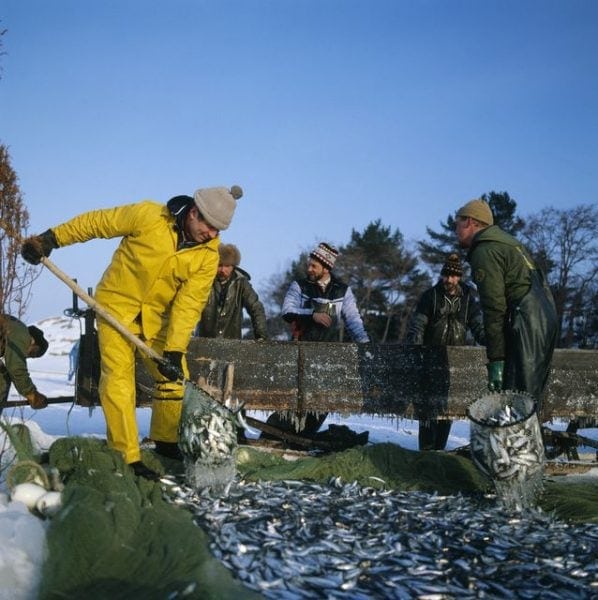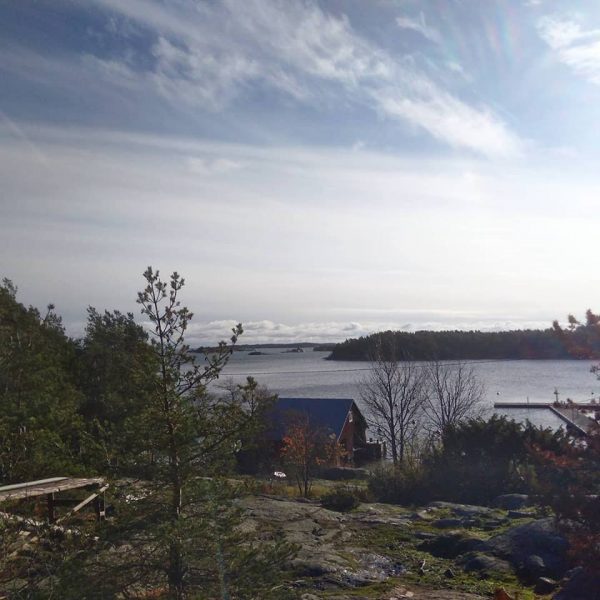Regulation and the Archipelago Sea
”You are looking at the last generation of coastal fishers!” a fisherman told me, as I was getting my coffee at a seminar celebrating the 100th anniversary of Independent Finland’s fisheries of the Archipelago Sea, in December 2017. He was not one of my interviewees, but I knew who he was anyway. After all, there are not so many small-scale fishers, or — as they more often refer to themselves — coastal fishers in the area anymore.
The situation was totally different less than a century ago. The Archipelago Area, which consists of about 40,000 islands, making it one of the largest archipelagos in the world, was once characterized by its viable fishing communities, fishing and farming being the most significant livelihoods on the islands. In 1934 there were 3447 fishers in the southern parts of the Archipelago Sea alone, whereas by 2015 there were less than 100, with only a small proportion of full-time fishers. In general, coastal fishers practice their livelihood alone, or with their family members. 90% of Finnish fishers are small-scale. In the past 40 years, European fisheries (and fisheries globally) have been subjected to heavy regulations and governmental management, in order to ensure sustainable use of fish stocks. Fishing in Finland falls under the Common Fisheries Policy of the European Union. The Common Fisheries Policy “aims to ensure that fishing and aquaculture are environmentally, economically and socially sustainable and that they provide a source of healthy food for EU citizens” (European Commission 2018).
These regulations and managerial procedures have not, however, ensured the viability of small-scale fisheries. All over the world it has been noted that due to ever increasing regulations, small-scale fisheries are losing their flexibility, resilience and capacity to adapt, while they are facing at the same time the stress caused by urbanization, increasing competition, globalization and climate change.
Not only the environmental, but also the cultural, social and economic sustainabilities of fisheries are under serious threat, so one can reasonably ask the question: whose sustainability are we really talking about?

The Archipleago of southwest Finland by Kirsi Sonck-Rautio, 2017. All rights reserved.
Fishing communities
The distinguished fisheries researcher Svein Jentoft (2000) stated that viable fisheries need viable fish stocks, but that is not the whole truth. Jentoft argued, and many fisheries researchers agree, that viable fish stocks also need viable fisheries communities. He also argued that fishers who no longer have social responsibilities, whose moral bonds and values are loosened due to the lack of community, are no longer good “stewards” for the resources they are exploiting. This leads to overfishing which, according to Jentoft, could be prevented, if fisheries management were aimed at sustaining the well-being of the fisheries communities instead of concerning itself with fish stocks exclusively. The notion of traditional values of the community ensuring sustainable use of resources should be problematized, of course, since traditional fishing can be just as unsustainable as modern one. Nevertheless, being subjected to strict top-down management has certainly had an influence on the spirit of my interviewees.
Is it true then, that fisheries management is not taking the community aspect into consideration? From the research and fieldwork I have conducted between 2015 and 2018 I can draw a few conclusions. Of course, there is no straight answer, but fishers who I interviewed feel very much left out of the decision-making processes. The interviewed administrators and managers in the local fisheries sector mostly side with fishers, saying that the ability of local fishers to have an impact on policies and regulations is rather minimal. Even the scientists who provide data to inform decision-making processes are very much divided in their opinions about the state of aquatic ecosystems and what kind of procedures should be applied.
Multi-species competition
The factor that the fishers feel is most threatening to their livelihood today is not climate change or the eutrophication of the Baltic Sea (which is caused by excess nutrients originating from farming, industry and habitation, and which cause intensified algae growth, oxygen depletion and changes in species composition), but the emergence of competing species (although climate change could well be a factor in this). The grey seal, which is no stranger to the area, but was almost hunted to extinction before 1980, has reappeared. Today, a population of almost 10,000 individuals is residing in the Archipelago Sea. Nowadays a protected species, its hunting is strictly regulated. Also, due to the EU ban for seal products (Regulation (EC) No 1007/2009), the selling of any seal artefacts is forbidden, making the seal, from the fishers’ point of view, a nuisance instead of a resource. Seals are causing considerable economic loss to fisheries all over the Baltic Sea, since they are able to tear fishing nets apart to eat the fish. Maybe even more importantly, fish are fleeing the seals, seeking shelter in the shallow bays, where fishing is prohibited.
Many fishers have been forced to give up their traditional fishing waters, in which their families have been fishing for generations, since there is simply not enough fish to harvest anymore.
Another species the fishers are up against is the great cormorant. Cormorants arrived to Finland in 1996, with the amount of nesting pairs increasing exponentially since. In 2018 the number of breeding couples in Finnish waters reached its peak at 26,700 pairs. Over 20% of this population live in the Archipelago Sea area. The great cormorant is protected by the EU wild bird directive. From the fishers’ view, great cormorants are extracting significant amounts of pikeperch and perch, two important commercial species, from the Sea. Great cormorants are not only disliked for their eating habits, but their nesting habits as well: to find an islet covered with cormorant feces and with the entire flora dead is a common sight for the people who sail the Archipelago Sea.

Fishers and Winter by Teuvo Kanerva (1975-1986). The Collection of Finnish Heritage Agency CC.
Endangered species
At the same time, scientists have found that the pike perch is developing earlier maturation. This means that they are gaining their spawning age earlier (and smaller), thus promoting larger numbers of smaller sized fish. This is of course bad news for fishers. The common opinion is that this development is fishing-induced, since the fishers naturally prefer to extract the bigger fish from the water. Therefore new fishing regulations were introduced: the minimum landing size of pike perch was raised to 40cm. For coastal fishers, this is catastrophic, since pike perch is commercially very important.
Now, one would think that fishers would endorse regulations which aim to ensure the growth and abundance of fish stocks. It is not so simple, however. Why not?
“We are the ones who are endangered here. But no one cares”, a fisherman told me. “Whose green”, we might hence ask, are the environmental rules which are increasingly ruling fishing lives? The fisher went on to explain how unfair it is that seals and cormorants are protected, while fishers are constantly punished with stricter regulations, even though the protected species also consume significant amounts of fish. Fishers are not only afraid for their own livelihood, but for the existence of coastal fisheries altogether. Newcomers to the industry have quickly given up after experiencing how hard it is to fight the seals, the cormorants, and the regulations which neither acknowledge their predicament nor have any power to change it.
Power and knowledge
Knowledge is power, and scientific research concerning fisheries plays a key role in decision-making.
By contrast, local ecological knowledge has no room in these decision-making processes. In fact, the fishing communities’ ecological knowledge is rarely acknowledged in scientific research on fisheries either.
It matters how research questions are formatted, or what kind of methodology is used. For example, most of the fisheries-related decisions are based on statistics. This type of research does not include any reflections from the practitioners themselves. The statistics concern the amount of fish harvested or the amount of fishing vessels owned or how many registered fishers are operating. Fishing, however, is so much more. When it comes to the local ecosystem, people are not considered experts of the system in which they work and live. Fishers tell of researchers who have called them liars, or disregarded their observations and views as false, since their scientific models do not support the fishers’ views on things. This has created a lot of bitterness among the fishing community, making them unwilling to work with scientists. “Why would we?” asked one fishermen, “every time we do work with scientists, we only get more regulations. They do not consider us experts, and there is no money and nothing to gain.”
There is an obvious conflict here, which is further exacerbated by the fact that the science on fisheries is itself deeply divided. All of the scientists I interviewed agreed upon the fact that coastal fisheries are in crisis; however, there is disagreement about how this crisis should be solved. Some feel that fishers should be included more in scientific research (although they may not know how that should be done), while others feel that even though the observations of fishers are important to note, it is up to scientists to do the analysis and make conclusions. For example, while all of the fishers I interviewed concurred that the existence of the grey seal is changing the behavior of fish, causing them to flee their traditional routes, not all scientists agree. One view is that there are other factors involved, and the seals are not to blame. Although the official view of the environmental administration is that the great cormorants’ impact on the local ecosystems is not substantial and that therefore there is no reason to start regulating the bird population with egg-pricking, there is a large group of marine biologists and ecologists who think otherwise, and who have argued that, in the popular fishing areas, the great cormorant does in fact extract similar amounts of fish from the sea the fishers do (Hansson et al. 2017). Therefore, the impact of the great cormorant in specific ecosystems is significant. The question the fishers are then asking is why the regulations are only directed at fishers, and not at the competing species as well. This may be because the decisions regarding the conservation of species are actually made by the environmental administration, whose objective is to conserve wildlife, not livelihoods nor cultural heritage.
So fisheries-related decision-making has not only eluded the reach of the fishers: it has been assigned to institutions which do not advocate fisheries-related issues.

Old fisher’s Island of Brännskär. Kirsi Sonck-Rautio, 2018. All rights reserved
Ethnography and other voices
Svein Jentoft (2000) has suggested community-based co-management as solution to the problems in fisheries management. Community-based co-management would empower fishers, produce more locally applicable and appropriate management and enhance the sense of community. However, as Jentoft himself realized, it would create power imbalances. Power would likely be centralized in the hands of a few fishers’ representatives, marginalizing others. Including local ecological knowledge and ethnographic research in the co-managerial process might go some way towards addressing these problems. In this way, decisions could be based on both scientific knowledge and local ecological knowledge, gathered among the fishers of the community, regardless of their position and status. Fishers may tell us something about fish stocks that the scientific parameters such as biomass and maximum sustainable yield cannot provide, as fisheries researcher Philip A. Loring (2017) put it. After all, fish are important actors in the socio-ecological system, but as they cannot speak for themselves, the fishers, who actually possess a lot of knowledge on fish, could maybe do some of the speaking for them.
Of course, even if the fishers were granted some power over their own livelihood, way of life, and cultural heritage, they would still have to face the fact that ecology is political, and sharing resources is fiercely political.
In addition to dealing with multispecies competition, fishers also have to deal with vilifying campaigns, conflict between conservation groups and recreational fishers (almost every third Finn is a recreational fisher), who are extracting almost the same amount of fish, but who are not subjected to the same regulations at the managerial level. No wonder it is hard to find new generations to take over the Archipelago’s fisheries.
Featured image: Fisher and his nets by Teuvo Kanerva (1975-1986), the collection of Finnish Heritage Agency CC.
REFERENCES:
Hansson, Sture, Ulf Bergström, Erik Bonsdorff, Tero Härkönen, Niels Jepsen, Lena Kautsky, Karl Lundström, Sven-Gunnar Lunneryd, Maria Ovegård, Juhani Salmi, Dmitry Sendek, Markus Vetemaa 2017. “Competition for the fish – fish extraction from the Baltic Sea by humans, aquatic mammals, and birds”. ICES Journal of Marine Science, Volume 75, Issue 3, 1 May 2018, Pages 999–1008, https://doi.org/10.1093/icesjms/fsx207
Jentoft, Svein 2000. The community: a missing link of fisheries management. In Marine Policy vol 24 issue 1: 53-60
Loring, Philip A. 2017. The political ecology of gear bans in two fisheries: Florida’s net ban and Alaska’s Salmon wars. In Fish and fisheries 18: 94-104







